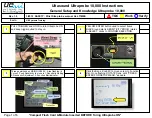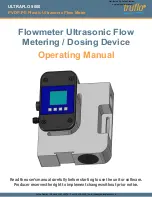
MANUAL: 55308
REV: A
ECO: 49582
8
4 POWERING
4.1 Installation
Before connecting the low-noise cable from the accelerometer to the charge amplifier, be sure to ground both
the charge amplifier and the cable. This ensures that an excessive static charge that may have accumulated
across the accelerometer or cable is harmlessly discharged. Failure to observe this precaution can result in the
destruction of the input FET of certain amplifiers.
Connect the transducer to the input of a PCB
differential or equivalent charge amp using low
noise cable.
Note: For optimum noise
performance, the cable length between the sensor
and the charge AMP should be minimized.
Connect the output of the charge AMP to any ICP
® signal conditioner using standard cable. Finally,
the output of the signal conditioner may then be
connected to an oscilloscope or other monitoring
device. This output will be an AC signal (see
specification
for actual frequency response) with
a DC bias. Many PCB signal conditioners remove
the bias via an AC coupling circuit.
4.2 Operation
Once each element is connected, allow a few
minutes for the system to thermally stabilize. Place
the switch on the charge amplifier in the OPERATE
position and proceed with the measurement.
It
is
often
convenient
to
normalize
the
accelerometer and charge amplifier system to a
precise sensitivity, such as 10.0 or 100.0 mV/g for
ease of data analysis. This is accomplished with
most PCB laboratory charge amplifiers and some
miniature in-line units as well.
For fixed sensitivity charge converters, the system
sensitivity (mV/g) is determined as the product of
the charge amplifier sensitivity (mV/pC) and the
charge sensitivity of the accelerometer (pC/g).
Note:
When using charge-amplified systems, the
noise floor of the system is dependent on the input
capacitance to the charge amplifier. Since the cable
adds to the capacitance and to minimize the noise
threshold, keep the cable length between the
accelerometer and the charge amplifier to a
minimum. Cable length does not affect the system
sensitivity of charge-amplified systems.
Since charge amplifier operation varies, please
contact the respective signal conditioner
manufacturer or check the product manual for
additional information.
5
HIGH-TEMPERATURE
OPERATION
5.1 Introduction














































